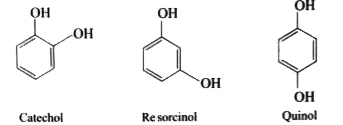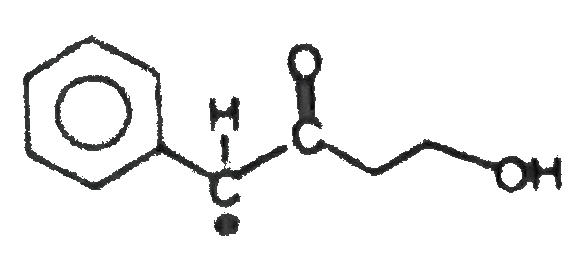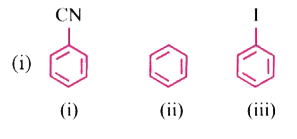InterviewSolution
This section includes InterviewSolutions, each offering curated multiple-choice questions to sharpen your knowledge and support exam preparation. Choose a topic below to get started.
| 10201. |
Which of the following is used for dehydration alcohol ? |
|
Answer» 85% PHOSPHORIC ACID |
|
| 10202. |
Which of the following statement(s) is/are incorrect? (i).Trichlorides on hydrolysis in water form tetrahedral [M(OH)_(4)]^(-) species. (ii). Hybridisation state of metal in tetrahedral species is sp^(3). (iii).Aluminium chloride in acidified aqueous solution forms [Al(OH)_(4)]^(-) ion. |
|
Answer» (i) and (ii) |
|
| 10203. |
Write the hybridisation and magnetic characters of the following complexes : [Ni(CO)_(4)] [Atomic number : Fe=26,Co=27,Ni=28] |
|
Answer» Solution :`[NI(CO)_(4)]` HYBRIDISATION `=sp^(3)` Magnetic character = DIAMAGNETIC |
|
| 10204. |
Which of the following has least coagluating value for positive sol ? |
|
Answer» `CL^(-)` |
|
| 10205. |
The term order and molecularity are common in chemical kinetics. Write Arrhenius equation. |
| Answer» SOLUTION :ARRHENIUS equation is k=`A bareE_a/(RT)`,where k is the rate CONSTANT,`E_a`is the ENERGY of activation | |
| 10206. |
Which of the amino acid is optically inactive ? |
|
Answer» Alanine |
|
| 10207. |
There are certain substances which behave as normal, strong electrolytes at low concentration but at higher concentration they behave as colloidal solution due to the formation of aggregated particles. Such colloids are called associated colloids and the aggregated particles are called micelles. Soaps anddetergents are the examples of associated colloids. The formation of micelles takes place above certain concentration called critical micellization concentration (CMC) and a characteristic temperature called Kraft temperature (T_k). What type of molecules form micelles |
|
Answer» NON - polar MOLECULES |
|
| 10208. |
There are certain substances which behave as normal, strong electrolytes at low concentration but at higher concentration they behave as colloidal solution due to the formation of aggregated particles. Such colloids are called associated colloids and the aggregated particles are called micelles. Soaps anddetergents are the examples of associated colloids. The formation of micelles takes place above certain concentration called critical micellization concentration (CMC) and a characteristic temperature called Kraft temperature (T_k). Micelles are formed only |
|
Answer» below the CMC |
|
| 10209. |
What is the difference between disinfectants and antiseptics? Can the same chemcial be used for both the pruposes? |
| Answer» Solution :Chemical compounds are used for killing or preventing the growth of MICROORGANISMS. Compounds when APPLIED to LIVING tissues like wounds, CUTS, ULCERS and diseased skin surfaces are called antiseptics. However when applied to inanimate objects like floors and drainage systems, they are called disinfectants. Same chemical in low concentration may be used as antiseptic and in high concentration as disinfectants. 0.2% Phenol solution is antiseptic but 1% phenol solution is disinfectant. | |
| 10210. |
Write the conductivity order o f aluminium I phosphide, silicon and cadmium sulphide. |
| Answer» Solution :At room temperature, conductivity will be more if the POLARITY of the COVALENT BOND is more. Si - Sibond is non-polar, AI - P bond is SLIGHTLY polar and Cd - S bond is more polar. Increasing order of conductivity : Silicon `lt` Aluminium phosphide `lt`Cadmium sulphide | |
| 10212. |
Which one of the following does not undergo friedel crafts reaction? |
|
Answer»

|
|
| 10213. |
Which reaction process with increase in entropy? |
|
Answer» `CaCO_(2) to CaO + CO_(2)` |
|
| 10214. |
(X) + K_2CO_3 + Air overset(heat)rarr (Y) (Y)+Cl_2 rarr (Z) Pink which of the following is correct ? |
|
Answer» X back , `MnO_2`Y = BLUE, `K_2CrO_4,Z=KMnO_4` |
|
| 10215. |
What are dihydric phenols? Give three examples. |
Answer» Solution :When BENZENE RING has 2 -OH groups, it is CALLED Dihydric phenol. 
|
|
| 10216. |
Why boiling pointsof phenols are higher than those of the corresponding aromatic hydrocarbons and alkyl halides? |
| Answer» Solution :Due to INTERMOLECULAR H-bonding PHENOLS have higher boiling point than the corresponding aromatic hydrocarbons which have only WEAK van DER waals forces of attraction. | |
| 10217. |
Which of the following hybrid state is associated with low spin complex ? |
|
Answer» `sp^3` |
|
| 10218. |
Which of the following is not an organometallic compound? |
|
Answer» `C_(6)H_(5)Ti(OC_(3)H_(7))_(3)` |
|
| 10219. |
Which of the following is incorrect match |
|
Answer» STABILITY `H_2O gt H_2S gt H_2SeH_2Te` |
|
| 10220. |
Which of the following in most acidic ? |
|
Answer» PHENOL |
|
| 10221. |
When huge amount of sewage is dumped into a river, the BOD will |
|
Answer» Increase |
|
| 10223. |
What are d-block and f-block elements? |
|
Answer» Solution :In a PERIODIC table, the elements PERSENT in GROUP 3.12 in which the d-orbitals are progressibely filled in each of the four long periods are CALLED d-block elements. These elements are referred as transition elements The elements in which the 4f and 5f-orbitals are successively filled are called f-block elements. The f-block elements are placed seperately at the bottom of the periodic table. These elements are referred as INNER transition elements. |
|
| 10224. |
Various constituents of liquid possess different boiling points, So they can be separated by fractional distillation. It can be done by using claude's apparatus. When condensed air passed through Claude's apparatus, both oxygen and Nitrogen ger condensed separately. He and Ne are collected with liquid nitrogen. Ar, Kr, Xe are collected with liquid oxygen. After removal of N_2 by heating with CaC_2 He & Ne are cooled to 20 K with liquid H_2 After removal of O_2 with Cu, Ar, Kr, Xe are cooled with liquid nitrogen and Ar separated out. Finally liquid kr and Xe can be separated by fractional distillation : In this process the chemical that is not involved |
|
Answer» He, Xe `2CU + O_2 to 2CuO` `{:(Ar to 87.28),(O_2 to 90.0):}}`NEARLY same VALUES |
|
| 10225. |
Which of the following does not exist? |
|
Answer» `WO_(4)^(2-)` `2CU^(2+) + 4I^(-) RARR underset(("WHITE ppt"))(Cu_(2) I_(2))` + I_(2)` |
|
| 10226. |
Vucanized rubber resists: |
|
Answer» WEAR and TEAR DUE to friction |
|
| 10227. |
The reagent with which both aldehyde and acetone ract easily is |
|
Answer» FEHLING's REAGENT |
|
| 10228. |
Which is the intensive property: |
|
Answer» Temperature |
|
| 10229. |
What is optical activity ? Which one of the following compounds shows optical isomerism ? Br-underset(CH_(3))underset(|)overset(H)overset(|)(C)-Br"" Br-underset(CH_(3))underset(|)overset(OH)overset(|)(C)-COOH |
|
Answer» SOLUTION :It is the property of a compound by which its solution can rotate the PLANE of plane polarized light. will show OPTICAL isomerism. `Br-underset(CH_(3))underset(|)overset(OH)overset(|)C-COOH` will show optical isomerism. |
|
| 10230. |
The reagent (s)for the followiingconversation |
|
Answer» alcoholicKOH |
|
| 10231. |
Which of the following has been universally accepted as a reference electrode at all temperature and has been assigned a value of zero volt |
|
Answer» GRAPHITE electrode |
|
| 10232. |
The unit of ebulioscopic constanat is |
|
Answer» `"K kg "MOL^(-1)"or "K^(-1)("MOLALITY")^(-1)` |
|
| 10233. |
Which of the following represents chloroprene , the monmer of neoprene ? |
|
Answer» `CH_(2)=CH-CH=CH_(2)Cl` |
|
| 10234. |
Which of the following will most readily dehydrated in acidic conditions? |
|
Answer»
|
|
| 10235. |
What is the basicity of H_(3)PO_(3) is heated? |
Answer» SOLUTION :`H_3PO_4` has THREE replacable HYDROGENS. Hence, its BASICITY is 3.
|
|
| 10236. |
When 3, 3-dimethyl 2-butanol is heated with H_2SO_4 the major product obtained is |
|
Answer» 2, 3-dimethylbut-1-ene |
|
| 10237. |
Which of the following is a branched polymer, having branched chain polysaccharide units ? |
| Answer» Answer :A | |
| 10238. |
Which of the following undergoes decarboxylation most readily on being heated ? |
|
Answer»

|
|
| 10239. |
Threeangular momentum of an electron in bohr 's orbit of hydrogen atom is 4.217 xx 10^(34) kgm^(2)S^(-1)what will be the wavelength emitted when this electron falls from this level to its next lower level |
| Answer» Answer :D | |
| 10240. |
Which is a primary alcohol ? |
|
Answer» Butan-2-ol |
|
| 10241. |
The solubility of [Co(NH)_(3))_(4)Cl_(4)]CIO_(4)____if the lambda_(Co(NH_(3))_(4)Cl_(2)^(+)=50, lambda_(ClO_(4)^(-)=70 and the measured resistance was 35.5 Omega in a cell with cell constant of 0.20 is ____ |
|
Answer» 59.75 mmol/L `lambda_([CO(NH_3)_4Cl_2]ClO_4)=(1000 K)/M` `K=G SIGMA` =1/33.5x0.20 `lambda_([CO(NH_3)_4Cl_2]ClO_4)=120xx(1000xx0.20)/(33.5xxM)` `M=(1000xx0.20)/(33.5xx120)=49.75` mmol/L |
|
| 10242. |
Write the structures of main products when benzene diazonium chloride reacts with the following reagents: (i) CuCN"" (ii) CH_(3)CH_(2)OH"" (iii) Kl |
Answer» SOLUTION :
|
|
| 10243. |
Which one of the following does not give a precipitate with anexcess of aqueous NaOH solution ? |
|
Answer» `ZnSO_(4)` |
|
| 10244. |
What is true for Lamda_(m(NH_(4)OH))^(@) ? |
|
Answer» `Lamda_(m(NaOH))^(@)+Lamda_(m(NH_(4)Cl))^(@)-Lamda_(m(HCl))^(@)` (ii) `Lamda_(m(NaOH))^(@)=lamda_(m(Na^(+)))^(@)+lamda_(m(OH^(-)))^(@)` (iii) `Lamda_(m(NaCl))^(@)=lamda_(m(Na^(+)))^(@)+lamda_(m(Cl^(-)))^(@)` `therefore (i)+(ii)-(iii)=lamda_(m(NH_(4)^(+)))^(@)+lamda_(m(OH^(-)))^(@)` `=lamda_(m(NH_(4)Cl))^(@)`, so OPTION (B) is right. So, if REPEAT accordingly, then option (A), (C) and (D) are wrong, as they are not the value of `Lamda_(m)^(@)(NH_(4)OH)`. |
|
| 10245. |
The standard conditions for determination of standard emf of the cell are |
|
Answer» 1M SOLUTION of the reactant |
|
| 10246. |
Which of these is true ? |
|
Answer» Wave FUNCTION `(Psi)` does not have any physical signifiance |
|
| 10247. |
The solubility of pure nitrogen gas at 25^(@)C and 1 atm 6.8xx10^(-4) mol/L. What is the concentration of nitrogen nitrogen dissoved in water under atmospheric condition ? The partial pressure of nitrogen gas in atmosphere is 0.78 atm. |
|
Answer» `"According toHenny's Law, C=K_(H)P` `(6.8xx10^(-4)molL^(-1))=K_(H)(1 atm)` `K_(H)=6.8xx10^(-4)molL^(-1)atm^(-1)` Step II. Calculation of solubility of NITROGEN gas in water `C=(6.8xx10^(-4)mol L^(-1) atm^(-1))xx(1 atm)` `=5.3 xx 10^(-4)mol L^(-1)=5.3xx10^(-4)M` |
|
| 10248. |
Which of the following is not an ionic halide ? |
|
Answer» `UF_(4)` |
|
| 10249. |
When mango is placed in 1N HCl solution, it |
|
Answer» swells |
|
| 10250. |
What is the correct IUPAC name of the following compound ? CH_(3)(CH_(2))_(4)underset(CH_(3))underset(|)(CH)-underset((CH_(2))_(2)CH_(3))underset(|)overset(CH_(3))overset(|)(C)-CH_(2)CH_(3) |
|
Answer» 3,4-Dimethyl-3-n-propylnonane |
|